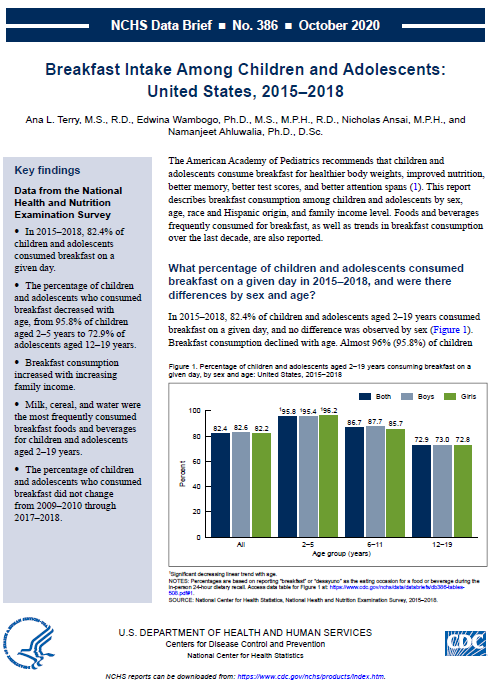Breakfast Intake Among Children and Adolescents: United States, 2015–2018
Posted on by Questions for Ana Terry, Health Statistician and Lead Author of “Breakfast Intake Among Children and Adolescents: United States, 2015–2018.”
Questions for Ana Terry, Health Statistician and Lead Author of “Breakfast Intake Among Children and Adolescents: United States, 2015–2018.”
Q: Was there a specific finding in the data that surprised you from this report?
AT: It was interesting to see that the percentage of breakfast intake among adolescents was more than 20 percentage points lower than younger children: 73% of adolescents aged 12-19 and 96% of children aged 2-5 years old consumed breakfast.
Q: How did you obtain this data for this report?
AT: We assessed data from the National Health and Nutrition Examination Survey, in which survey participants were asked to report all foods and beverages they consumed in the previous 24 hours, from midnight to midnight. We looked at children and adolescents, aged 2-19 years who reported eating “breakfast” (or “desayuno”).
Q: Is there any trend data that goes back further than 2009-2010?
AT: The National Health and Nutrition Examination Survey has been collecting diet intake information since 1971, for almost 50 years. We focused on breakfast consumption in the past 10 years for this report.
Q: What is the take home message for this report?
AT: Overall, we found that from 2015 to 2018, 82% of children and adolescents consumed breakfast on a given day; breakfast consumption decreased with age and was higher among children & adolescents from families with higher incomes; a lower percentage of non-Hispanic black children and adolescents consumed breakfast; and that milk, cereal, and water were the most commonly reported foods or beverages. The percentage of children and adolescents who consumed breakfast did not change in the past 10 years.
Q: Is there data on lunch and dinner?
AT: Yes, the National Health and Nutrition Examination Survey, which is the source of the data, conducts a 24-hour dietary recall, by which we gather information on all foods and beverages consumed by the participant in the previous 24 hours. Diet intake data is available for researchers to assess which meals and snacks were reported, the time of the day for each meal or snack, and the foods and beverages that were consumed. For this data brief, we focused on breakfast consumption from 2015 to 2018.
Posted on by

